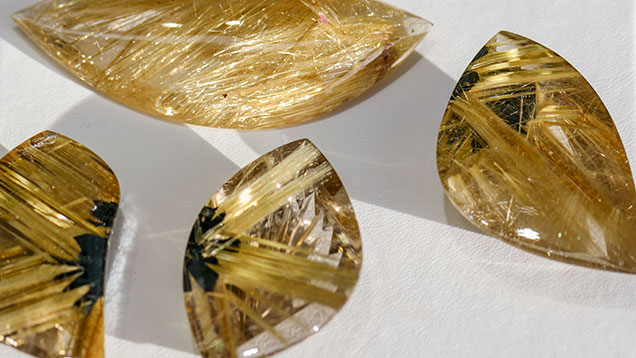Tucson 2015 Overview
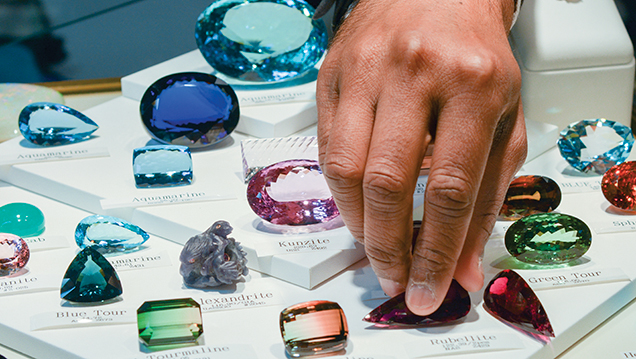
Once again, buyers and sellers from all over the world converged on a corner of the American Southwest for the annual Tucson gem shows. Many broad trends continued from 2014: Consuming markets are hungry for fine colored gems, and demand still outstrips supply, causing prices for some gems to reach new highs. As more buyers from Asia compete for new production of rough gemstones, the secondary market is becoming more important for domestic dealers. Many recycled gems and jewelry pieces were returning to the market through estate sales, or directly from owners lured by all-time high prices. Some sellers were showing items that had been held in inventory for years or even decades (figure 1). These included fine corundum, Imperial topaz, red spinel, and aquamarine. We noted that many of these “recirculated” goods were exceptional gems, superior to newly mined production. Many vendors are unable to source new production at prices their clientele are prepared to pay.
Cultured pearls of every type were in high demand—especially from the Chinese market. The same was true of rubellite and “watermelon” tourmaline, tsavorite, and spinel, especially red to pink material from Mahenge, Tanzania.
Overall, we observed several clear trends:
- Many gem-quality stones were cut in nontraditional shapes such as cabochons, fantasy cuts, carvings (figure 2), and even slices.
- Many jewelry pieces had an organic, natural feel. Similarly, non-round pearls—particularly large baroque shapes—were also everywhere. The freeform shapes of many opals also fit well with natural-shape trends for jewelry, lending themselves to carved flowers, animals, and abstract pieces.
- Designers were seeking out unusual colors for standard gems: fancy-color sapphires, colored diamonds, tourmalines, spinel, garnets, zoisite, zircon, and beryl (morganite was very much in demand).
- Many vendors told us they left their “traditional” inventory items at home, as they can sell those at any time. The Tucson crowd demands the unusual (figure 3), so vendors brought nontraditional items and were reportedly selling them at a good pace.
- Even though red-brown “Marsala” was named the Pantone color of the year for 2015, it did not appear to be an overall favorite, with the most observed colors being bright blues, greens, and pinks.
- The largest crowds observed at the wholesale shows were gathered at the booths selling nontraditional gem materials such as cabochons, druzy, tourmalinated and rutilated quartz (again, see figure 2), and crystal slices—material typically used in “craft” jewelry.
- Opal (figure 4) was prominent: There was an abundance of Ethiopian hydrophane opal, Australian opal, Mexican fire opal, and material from the U.S. Recent finds in Ethiopia have generated a buzz for all types, according to several vendors.
Foot traffic at the main AGTA and GJX shows appeared down from 2014, but most merchants reported brisk sales, especially of very fine or unique items. In fact, many vendors mentioned that this was their best show in recent years. Eric Braunwart of Columbia Gem House (Vancouver, Washington) said he had forgotten what a “good year was like” until this show.
Alexander Wild (Wild & Petsch Lapidaries, Kirschweiler, Germany) provided a broad-brush market update from his firm’s perspective. Rough prices for many gems continued on an upward trajectory, he reported. Just a few years ago, fine-color, high-clarity rubellite tourmaline sold at wholesale for $300 to $350 per carat. These numbers reflected the asking price for superb quality, with perhaps just a few tiny inclusions. In 2015, prices for equivalent material are almost triple that figure.
As in the previous year, sourcing rough gems remains a problem, although it is by no means impossible for established companies with good connections in source countries, such as Wild & Petsch. The company is able to source quality rough, though prices are definitely higher for many goods. Since mid-2014, prices for many other commodities such as oil and copper have fallen. But gemstone rough prices continue to rise, largely due to demand from China. In Wild’s opinion, such high prices are unsustainable. He wondered how long this would continue, asking rhetorically, “Is this a gem bubble?”
Asked what was in demand, he answered that it was the gemstones Wild & Petsch is known for: fine tourmaline and beryl. With their African connections, they secured a nice production of Paraíba-type copper-bearing tourmaline from Mozambique, along with good parcels of aquamarine. As a result, they were able to offer their clientele this material at what Wild considered very fair market prices. In contrast, supply of rubellite and pink tourmaline rough is quite difficult, and most of his supply has been coming from Nigeria. Brazilian rubellite is basically unavailable.
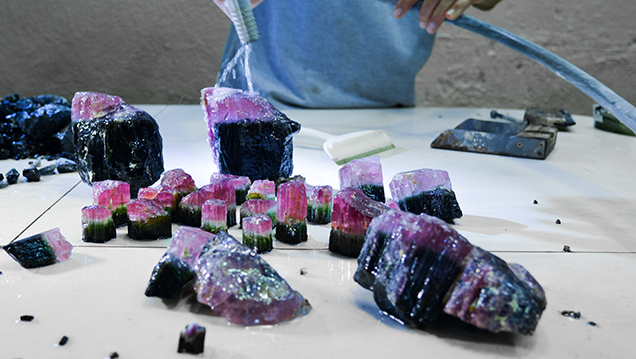
[Editor’s note: In a 2014 visit to Brazil’s Cruzeiro mine in Minas Gerais State, a GIA team witnessed recovery of large facet-grade rubellite crystals (figure 5), which were all put aside for exclusive sale to a consortium—composed of the Miranda Group and KGK—that fashions the material at its own factory in Shenzhen, China, for the Chinese market (figures 6 and 7). Only blue to green production was available for sale to local and export markets.]
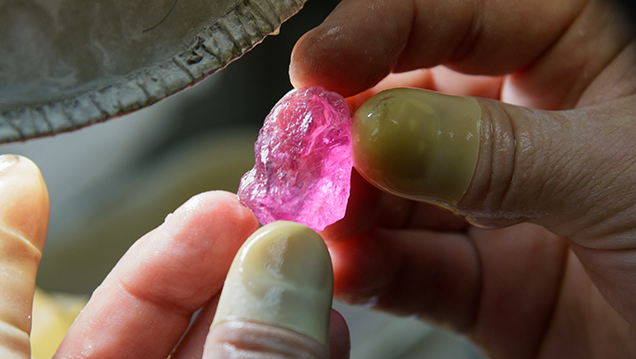
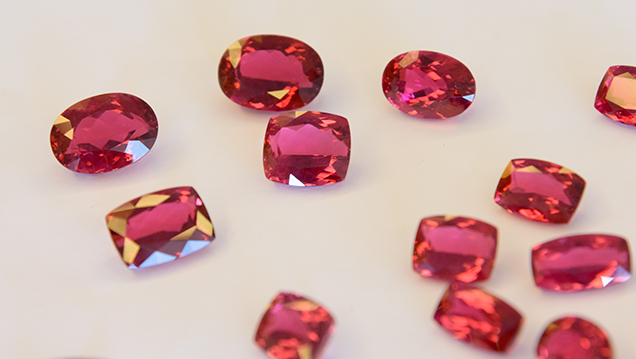
Adjusting to price fluctuations has always been part of life for colored stone merchants, Wild conceded, but not sudden, successive increases to levels that are three, four, or five times higher than the market was previously accustomed to (see www.gia.edu/gia-news-research-miranda-journey-of-rubellite-tourmaline).
Wild offered the possibility that at some point a single market will be satisfied—even one as large as China’s. When that happens, suppliers will have to find other markets for these goods. Wild believes the North American and European markets are more sophisticated in terms of pricing—especially for cut goods—than China’s current market. There is also the possibility that any political upheavals there could cause rough prices for certain gems to go down sharply, he said. And that could spell trouble for some miners who base their operations on today’s historically high rough gem prices.
Wild said business at the 2015 show had been better than the year before. He reckoned business was a third above 2014, with some big-ticket items—including a fine aquamarine suite—spoken for prior to the show. He confirmed our impression that traffic was down slightly from last year—possibly due to fewer Asian buyers or the winter travel difficulties on the U.S. East Coast.
Wild intimated that many clients came with specific requirements in mind, particularly aquamarine or Paraíba-type tourmaline, and selection was good for these gems at this year’s show. He mentioned they had even sold a few collectors’ pieces, including a beautiful large green step-cut beryl that measured more than 200 ct. That was a surprise to him, because such items have proven more difficult to sell the last few years.
“Everyone is searching for good things,” Wild concluded. “For the most part, we get what we need.” Asked if the trend is still toward finer, more unique pieces, Wild responded, “Absolutely. I think quality still comes first. A lot of the trends from last year still apply, and we’re still waiting to see if there’s going to be any deflation in pricing for some goods.”
Once again, G&G greatly appreciates the assistance of the many friends who shared material and information with us this year, with special thanks to the American Gem Trade Association for providing photography studio space during the AGTA show. Dr. Tao Hsu, Andy Lucas, Donna Beaton, Pedro Padua, and Dr. Jennifer Stone-Sundberg contributed to these reports.
